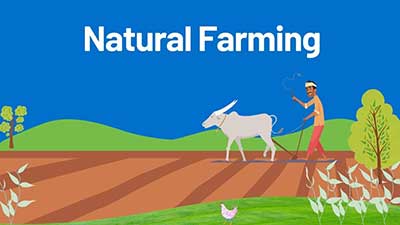Date: 10/01/2023
Relevance: GS-3: Major Crops - Cropping Patterns in various parts of the country, Agricultural produce and issues and related constraints
Key Phrases: Natural Farming, Green Revolution, Zero-Budget Natural Farming, Branding, Certification, PM Fasal Bima Yojana
Why in News?
- There is an urgent need to scale up alternative approaches of farming since, the negative impact of the Green Revolution has been heightened further by the pandemic.
- Natural farming needs to be practised on scale and in areas that do not impact food security. However, the natural farming in India has persistent uncertainties, making it an emotive issue.
What is Natural Farming
- Natural farming is a method of chemical-free agriculture drawing from traditional Indian practices.
- It is a unique model that relies on Agro-ecology aiming to bring down the cost of production and boost the return to a sustainable level.
- It asserts that there is no need for expensive inputs such as fertilisers, pesticides and intensive irrigation.
- Natural farming encourages the breakdown of organic matter by microorganisms and earthworms right on the soil surface, gradually adding nutrients to the soil over time.
- In organic farming, however, organic fertilizers and manures, such as compost, vermi-compost, and cow dung manure, are utilized and applied to farming land.
Prospects of Natural farming:
- India has the first mover advantage in the label of ‘Natural’ in the global agricultural export market because of diversity and different types of Natural farming practices found across the nation. This creates huge opportunities for exports.
- The label of Natural in agriculture is wider and deeper than ‘Organic’ in view of social and economic benefits.
- The label of organic is well matured vis-a-vis natural farming and therefore, the financial assistance on natural farming should be equivalent to organic agriculture.
Similarities Between Organic and Natural Farming
- Both natural and organic farming methods are chemical-free and, to a large extent.
- Both systems restrict farmers from using chemical fertilizers and pesticides on plants, as well as from engaging in any other agricultural practices.
- Both encouraged to use local seed breeds and native cultivars of vegetables, cereals, legumes, as well as other crops in both farming methods.
- Non Chemical and homemade pest control solutions are promoted by organic and natural farming methods.
Difference between natural farming and organic farming:
- In natural farming the focus is on the use of bio inputs prepared from farm and local ecosystems instead of purchasing those from outside.
- Organic farming is defined now more from a perspective of product certification. Except for such certification, organic and natural farming in India are largely similar.
- What binds organic and natural farming proponents is the thrust on the absence of application of chemical fertilisers or chemical pesticides during cultivation.
- In organic farming, farmers might use "external agricultural inputs" such as rock phosphate, biopesticides and biofertilizers, but even these external applications are not required in natural farming, as the farm itself can generate much of the inputs required a thus, called as Zero-Budget Natural Farming.
Impact of Green Revolution:
- India’s Green Revolution in the 1960s was based on high-yielding varieties, irrigation and fertilisers.
- The Green Revolution transformed India from a ‘ship-to-mouth’ existence, through the American PL-480 food grants, to a food-secure, agri-exporting nation.
- India moved into a different realm and created a huge stability and resilience.
- Hence, it is time to look back at the past and prevailing successful examples and stop being diffident.
Measures to Scale Up Natural farming:
- Promoting in tribal and rain fed areas:
- Rain-fed and tribal areas which are still not agri-input intensive, producing nutri-cereals, pulses and oilseeds are the ideal places to begin with.
- Productivity of these areas must be stabilised and improvised as nearly 55 per cent of the net sown area is rain-fed and 61 per cent of our farmers inhabit these areas.
- Promoting natural farming in rainfed areas beyond the Gangetic basin:
- Home to half of India’s farmers, rainfed regions use only a third of the fertilisers per hectare compared to the areas where irrigation is prevalent.
- Also, the farmers stand to gain as the current crop yields in these areas are low.
- Securing insurance of organic farmers:
- Enable automatic enrolment of farmers transitioning to chemical-free farming into the government’s crop insurance scheme, PM Fasal Bima Yojana (PMFBY).
- Any transition in agriculture — crop diversification, change in farming practices adds to the farmer’s risk. Covering such risks could enhance the appetite of the farmers to embark on the transition.
- Promote microenterprises that produce inputs for chemical-free
agriculture:
- Lack of readily available natural inputs acts as a barrier for farmers. For this setting up of village-level input preparation and sales shops can be explored.
- Leverage NGOs and champion farmers:
- For promoting and practising sustainable agriculture across the country, at least five million farmers are already practising some form of sustainable agriculture and hundreds of NGOs are involved in promoting them.
Conclusion:
- There is a huge political commitment to natural farming.
- Moreover, post Covid-19, the demand for immunity boosting natural food has increased, and urban population is ready to pay the price differential.
- There are many successful examples of natural farming around the country where agriculture is practised in conjunction with animal husbandry.
- Fertiliser subsidy is skyrocketing and fertiliser use efficiency is decreasing, but India is still dithering.
- It is time India looks at natural farming afresh, validate it scientifically and practice it on scale.
Source: Hindu BL
Mains Question:
Q. The food security in India with the help of Green revolution was accompanied by environmental damage impacting human and ecological health. In this context, discuss how natural framing promises a sustainable agriculture transition. (250 words)









